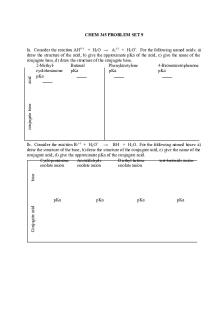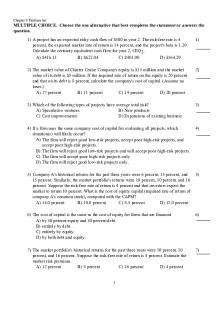Problem set 9 - Questions PDF

| Title | Problem set 9 - Questions |
|---|---|
| Course | Organic Chemistry I |
| Institution | Washington State University |
| Pages | 3 |
| File Size | 131.8 KB |
| File Type | |
| Total Downloads | 77 |
| Total Views | 190 |
Summary
Questions...
Description
CHEM 345 PROBLEM SET 9
conjugate base
acid
Ia. Consider the reaction AH(+) + H2O → A:(-) + H3O+. For the following named acids: a) draw the structure of the acid, b) give the approximate pKa of the acid, c) give the name of the conjugate base, d) draw the structure of the conjugate base. 2-MethylButanal Phenylacetylene 4-Bromoacetophenone cyclohexanone pKa pKa pKa pKa
base
Ib. Consider the reaction B:(-) + H3O+ → BH + H2O. For the following named bases: a) draw the structure of the base, b) draw the structure of the conjugate acid, c) give the name of the conjugate acid, d) give the approximate pKa of the conjugate acid. Cyclopentanone Acetaldehyde Diethyl ketone tert-butoxide anion enolate anion enolate anion enolate anion
Conjugate acid
pKa
pKa
pKa
pKa
II. Complete the following: stereochemistry and regiochemistry are important. O a)
f) type
Formation of (dimethyl) acetal
N
CHO type
EtO OEt b)
HO-NH 3 + Cl-
g) Hydrolysis of acetal
type
a) b)
c)
type HO O h)
Grignard Synthesis (of alcohols)
O
N
a) H2 / Ni b) aq HCl
type
CHO
OH
d)
OH
NaOAc, EtOH
c) type
N
CHO
i) OH type
type
e)
Ph
a)
a) NaBH4 , MeOH
O Ph
type
f ormation of a cyclic hemiacetal Br
j)
b)
OH
c)
b) aq. HCl type
III. Acetophenone is dissolved in ethylene glycol and the solution treated with a non-aqueous acid. After the reaction is complete the reaction mixture is neutralized and the cyclic Acetal is isolated. a) Write the reactions that have occurred; b) write a mechanism for the reaction of the acetophenone with the diol ethylene glycol. IV. While ethers are normally inert towards Grignard reagents, epoxides, because of ring strain, do react with Grignard reagents by a Sn2 reaction (backside attack) to give addition products. The reactions with epoxides are run in a manner similar to that for aldehydes and ketones in that the Grignard reagent, after preparation from the corresponding halide, is treated with the electrophile (carbonyl compound or epoxide), and then after the reaction is complete the reaction mixture is neutralized with aqueous NH4Cl (a weak acid). Write the reaction that would be expected from the reaction of Allyl Grignard reagent with ethylene oxide. V. Show how you could use a Grignard Synthesis (of alcohols) to prepare 5-hydroxy-5phenylpentanal from benzaldehyde and 4-bromobutanal. Hint: you will need to use a protecting group.
VI. Cyclohexanone reacts with cyclohexylamine with an acid catalyst. The reaction is run such that water is removed as it is produced. Write this reaction and draw a mechanism.
VII. A student tried to prepare 1-phenylpentane-1,5-diol by a Grignard synthesis using 4-bromo1-butanol and benzaldehyde. None of the desired product was obtained, but the student did isolate a small amount of 1-butanol from the reaction mixture. Write this reaction and determine what went wrong? What did the student not understand about Grignard reagents? VIII. The tertiary alcohol 2-phenylpent-4-en-2-ol can be synthesized by three separate methods using Grignard Chemistry. Draw those reactions....
Similar Free PDFs

Problem set 9 - Questions
- 3 Pages

Problem Set 9 (Answers)
- 12 Pages

Problem set 9 sheet
- 2 Pages

Problem Set 9-Solutions
- 6 Pages

Chapter 9 Problem Set
- 6 Pages

Problem Set 5 - Questions
- 2 Pages

Private Study Questions Set 9
- 2 Pages

Tutorial work - problem set 1-9
- 93 Pages

Solutions Problem set 7
- 11 Pages

Problem set 1-2
- 7 Pages
Popular Institutions
- Tinajero National High School - Annex
- Politeknik Caltex Riau
- Yokohama City University
- SGT University
- University of Al-Qadisiyah
- Divine Word College of Vigan
- Techniek College Rotterdam
- Universidade de Santiago
- Universiti Teknologi MARA Cawangan Johor Kampus Pasir Gudang
- Poltekkes Kemenkes Yogyakarta
- Baguio City National High School
- Colegio san marcos
- preparatoria uno
- Centro de Bachillerato Tecnológico Industrial y de Servicios No. 107
- Dalian Maritime University
- Quang Trung Secondary School
- Colegio Tecnológico en Informática
- Corporación Regional de Educación Superior
- Grupo CEDVA
- Dar Al Uloom University
- Centro de Estudios Preuniversitarios de la Universidad Nacional de Ingeniería
- 上智大学
- Aakash International School, Nuna Majara
- San Felipe Neri Catholic School
- Kang Chiao International School - New Taipei City
- Misamis Occidental National High School
- Institución Educativa Escuela Normal Juan Ladrilleros
- Kolehiyo ng Pantukan
- Batanes State College
- Instituto Continental
- Sekolah Menengah Kejuruan Kesehatan Kaltara (Tarakan)
- Colegio de La Inmaculada Concepcion - Cebu





